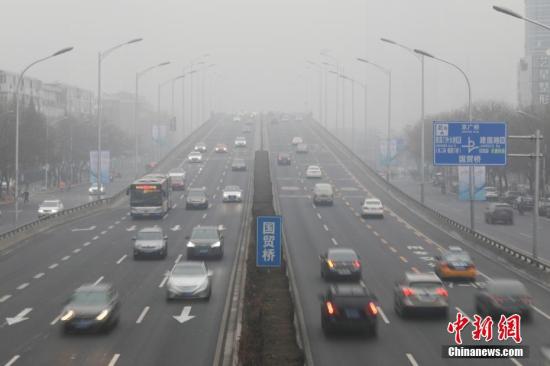China News Agency, Beijing, March 20 (Reporter Ruan Yulin) After implementing strong air pollution prevention measures, the frequency of severely polluted weather in China has dropped significantly. The latest research results released by China National Center for Atmospheric Pollution Control show that in 2019, 74 major cities in China had a total of 599 PM2.5 (fine particulate matter) hourly concentrations exceeding 300 micrograms per cubic meter, compared with 2013. It is down 94.2%.
On February 13, 2020, Beijing was severely polluted. Photo by China News Agency reporter Jiang Qiming
In order to further analyze the characteristics and laws of the heavy pollution process, the National Center for Atmospheric Pollution Prevention and Control has invited experts from the China National Environmental Monitoring Station and Peking University to analyze and interpret the national PM2.5 hour heavy pollution change trend since 2013.
The monitoring statistics of the National Urban Ambient Air Quality Monitoring Network covering 337 prefecture-level cities and above show that the number of PM2.5 heavy pollution days in prefecture-level cities across the country has declined significantly from 2015 to 2019, down from 3083 days in 2015. By 1813 days in 2019, the decrease has reached 41.2%, and the number of hours with a PM2.5 hour value exceeding 300 micrograms per cubic meter has decreased by 58.8% compared with 2015.
The results show that between 2015 and 2020, the number of PM2.5 heavily polluted days and PM2.5 hours of severely polluted hours will decrease significantly. From January to February 2020, the number of PM2.5 heavy pollution days in prefecture-level cities nationwide was the lowest in the same period in history, a decrease of 39.2% over the same period in 2015.
The monitoring of PM2.5 since 2013 shows that since 2013, the periods of extreme pollution of PM2.5 each year are mainly concentrated in autumn and winter, with the highest frequency occurring from November to January of the following year.
Among the 74 key cities in the country that implemented the new standards for ambient air quality, monitoring shows that in 2019, a total of 599 PM2.5 hour concentrations exceeded 300 micrograms per cubic meter, a decrease of 94.2 compared to 2013 %. From January to February 2020, a total of 199 PM2.5 hour concentrations in 74 cities exceeded 300 micrograms per cubic meter, a decrease of 96.1% over the same period in 2013. It shows that through the implementation of strong air pollution prevention measures, severely polluted weather has decreased significantly.
Experts believe that during the heavy pollution process, the hourly PM2.5 concentration growth rate in the city can reflect the cumulative growth rate of PM2.5 and the peak concentration that can be reached to a certain extent, and reflects the effectiveness of control during the heavy pollution process.
Looking at the growth rate of PM2.5 in 74 cities across the country during the period of heavy pollution, from 2013 to 2019, the growth rate of urban PM2.5 when the concentration reached a level of severe pollution or above fell by about 40%. During the pollution process, the peak concentration that PM2.5 can reach decreases significantly. Experts say that this is closely related to the peak-cut emergency emission reduction measures taken during the early warning of China's heavy pollution process.
According to the research results of Professor Hu Min's research team at Peking University, the concentration of ultrafine particles in the air in Beijing has been highest from 2013 to 2014 in the past ten years, and it has decreased significantly since 2015, and it has a trend of annual average PM2.5 concentration. Have better consistency. It shows that the currently adopted air pollution prevention and control measures effectively control the PM2.5 mass concentration, and also significantly reduce the nano-level ultrafine particle number concentration. (Finish)

